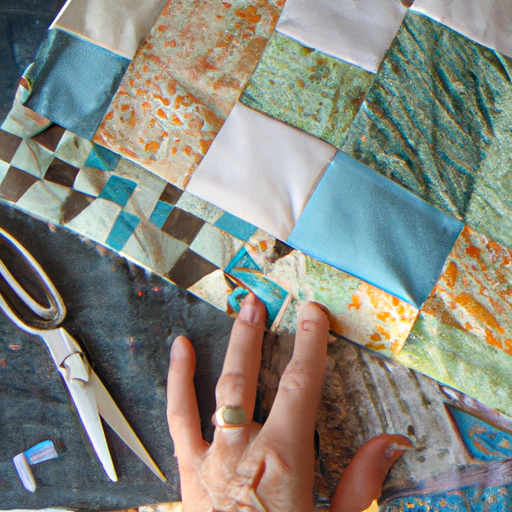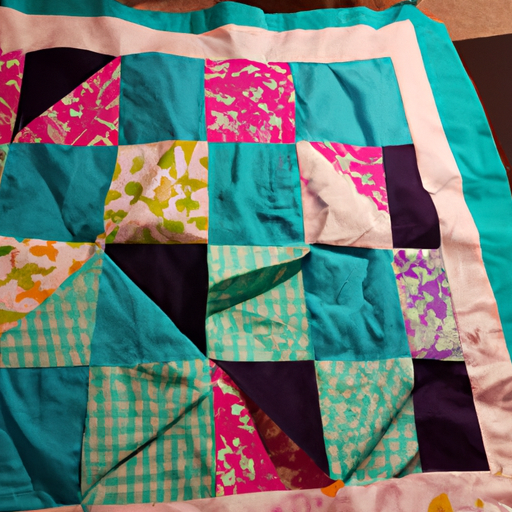
Can I teach myself to quilt?
The warmth of a handmade quilt, sewn with love and care, is a feeling like no other. There’s nothing quite like snuggling up under a quilt on a chilly evening and feeling its soft embrace. But, for many of us, the art of quilting seems like a lofty dream. The complexity of the patterns, the precision of the stitching, and the sheer volume of materials to work with can feel overwhelming. If you’ve ever asked yourself the question, „“ then know that you’re not alone. The truth is, with enough determination and a willingness to learn, anyone can master the art of quilting. So, let’s dive in and explore this beautiful craft, one stitch at a time.
1. Doubting Your Ability to Quilt? Let’s Set the Record Straight
Are you feeling discouraged because you think quilting may be too difficult for you? Don’t worry, because it’s time to set the record straight about your quilting ability.
First things first, quilting is not just for master quilters. Anyone can learn how to quilt with practice and patience. Don’t underestimate your potential because you haven’t yet honed your skills.
One of the most appealing aspects of quilting is its versatility. Whether you prefer modern or traditional styles, there is a quilting technique out there that will cater to your artistic tastes.
Feeling uncertain about your sewing skills? While having sewing experience is undoubtedly a plus, it’s not necessarily mandatory to start quilting. Quilting is not just sewing; it’s a unique form of creative expression that allows you to create something beautiful and tangible.
Remember, the most important step to quilting is just starting! Take the first step by researching project ideas, gathering materials, and learning basic techniques. You’ll undoubtedly experience obstacles and make mistakes along the way, but don’t give up. Persevering through these setbacks will only make you a better quilter in the long run.
- Believe in yourself and your ability to learn and create.
- Allow yourself to make mistakes and learn from them.
- Don’t compare yourself to other quilters; everyone has their unique style and learning process.
With confidence and a willingness to learn, you’ll be creating stunning quilt projects in no time. Just trust yourself, and remember that every quilting journey begins with a single stitch!
2. The Transformative Power of Quilting: Why Everyone Should Try It
Quilting has the power to transform people’s lives in ways they might never expect. For many, it’s more than just a craft – it’s a way of life that brings joy, comfort, and community. Here are just a few reasons why everyone should try quilting at least once in their lifetime:
Firstly, quilting is an excellent way to express creativity and relieve stress. It can be a soothing and meditative activity that allows you to focus on something other than daily worries and anxieties. Choosing fabric colors and patterns, figuring out a design, and piecing it all together can be extremely satisfying, especially when you see your finished product.
Secondly, quilting can be a wonderful form of self-care, especially for those who struggle with mental health issues. The repetitive motions of stitching and the sense of accomplishment that comes with creating something beautiful and functional can provide a sense of calm and purpose. It can also be a way to connect with others who share similar interests and experiences.
Thirdly, quilting has a rich history and tradition that can be both educational and inspiring. There are so many different styles, techniques, and cultural influences to explore. Learning about the history of quilting and the stories behind different patterns and designs can be a fascinating and eye-opening experience.
Finally, quilting is a way to give back to others and create a lasting legacy. Whether you’re making a quilt for a loved one or donating to a charity, quilting has the power to bring joy and comfort to others. It can also be a way to preserve family memories and traditions, passing them down to future generations.
In short, quilting has the power to transform individuals and communities. It’s more than just a hobby – it’s a way to connect with others, express creativity, relieve stress, and give back. So why not try quilting for yourself? You never know how it might change your life.
3. Exploring the Joy of Self-Taught Quilting: Overcoming Fear and Embracing Learning
Learning a new skill can be daunting but also immensely rewarding. Self-taught quilting is a great example of this. The journey of self-discovery as one learns to sew beautiful patchwork pieces is a joy like no other. However, for many, fear stands in the way of picking up this exciting new hobby. Fear of failure and not being good enough can keep individuals from even starting, but it’s important to remember that everyone starts somewhere. It’s important to embrace learning and understand that perfection is not the goal, but rather the beauty of imperfection.
Overcoming this fear can be done through taking small steps towards improvement. Start with beginner patterns and work your way up to more challenging projects. Take classes or tutorials online and practice often. Learning from mistakes and recognizing that every mistake is a learning opportunity rather than a failure, is key to embracing this new skill.
Creating a quilt from start to finish can bring about a tremendous sense of accomplishment. The satisfaction of completing a project that took time and dedication can be a rewarding experience that’s worth overcoming any fear. Surrounding oneself with a supportive community can also help in this journey. Engaging with others in the same mental state can make learning feel less intimidating and more fun.
In conclusion, self-taught quilting can be a joyful and fulfilling experience. Overcoming fear and embracing the learning process is key to unlocking this experience, and once the skill is acquired, the joy in making beautiful pieces of art is priceless. Remember to start small, practice often and have fun!
4. The Top Strategies for Teaching Yourself How to Quilt
Starting a new hobby can be both exciting and daunting. But don’t let the fear of the unknown hold you back from learning how to quilt! With the right strategies, you can teach yourself how to quilt and be on your way to creating beautiful and timeless pieces.
1. Invest in the right tools: A good quality rotary cutter, cutting mat, and ruler set are essential for a successful quilting experience. Make sure to also have plenty of fabric, thread, and batting on hand.
2. Start with simple projects: Begin with easy projects like placemats, pot holders, or small quilted items. This will help build confidence and allow you to practice various quilting techniques.
3. Take advantage of online resources: There are countless resources available online ranging from video tutorials to quilting blogs. Some popular resources include Jenny Doan’s tutorials on the Missouri Star Quilt Company YouTube channel and Suzy Quilts blog.
4. Join a quilting community: Connecting with other quilters can provide valuable support, guidance, and inspiration. Consider joining a local quilting group, attending a quilting retreat, or participating in online quilting communities.
Remember to have fun and don’t be too hard on yourself. Your first quilt may not be perfect, but with practice and patience, your quilting skills will improve. Happy quilting!
5. From Basic Steps to Complex Techniques: Unlocking Your Inner Quilter
Are you ready to unlock your inner quilter? Whether you’re a beginner or an experienced quilter, there are endless techniques to explore and build on. Here are some basic steps you can follow to help take your quilting skills to the next level.
1. Start with the Basics
Before diving into complex techniques, it’s important to master the basics. This means understanding how to properly use your sewing machine and how to accurately cut and piece fabric. A few basic skills can take you a long way in quilting.
2. Practice, Practice, Practice
Like anything in life, practice makes perfect. Practice piecing and quilting simple blocks before moving on to more complex patterns. This will help you gain confidence in your skills and develop a better understanding of quilting techniques.
3. Experiment with Color and Fabric
Don’t be afraid to experiment with color and fabric choices. Try sewing with different fabrics, patterns, and colors to discover what works best. Playing with different combinations can lead to some unexpected and stunning results.
4. Learn New Techniques
Once you’ve mastered the basics, it’s time to start learning new techniques. This can include everything from different piecing methods to more advanced quilting designs. There are many resources available online, in quilting books, and in classes to help you expand your skill set.
5. Challenge Yourself
Finally, don’t be afraid to challenge yourself. Take on a project that pushes you outside of your comfort zone. This may be a complicated pattern, a new fabric type, or a new technique. By pushing yourself, you’ll continue to grow your skills and creativity.
Quilting is a journey that requires patience, practice, and perseverance. By following these basic steps and unleashing your creativity, you can unlock your inner quilter and create beautiful, unique projects that reflect your personality and skill set. So, grab your sewing machine and let’s get quilting!
6. Joining the Quilting Community: Finding Inspiration and Support in Your Self-Taught Journey
Joining the quilting community can be a game-changing decision for anyone starting on a self-taught journey. Not only can you find valuable resources and inspiration, but you’ll also meet fellow quilters who share your passion for creating beautiful and meaningful pieces.
One way to start is by joining online quilting groups and forums. These communities are often welcoming and supportive, as members share their works, ask for advice, and offer tips and tricks for beginners. Don’t be shy to ask questions and engage with others; you never know what kind of friendships and learning opportunities you might discover.
Another great way to connect with the quilting community is by attending local workshops, retreats, or meet-and-greets. These events offer the chance to learn from experienced quilters, share your own techniques, and bond over your love for fabrics and patterns. Plus, they can provide a much-needed break from the solitary nature of quilting, giving you the chance to socialize and recharge your creative energy.
Finally, remember that being part of the quilting community doesn’t mean conforming to any standards or rules. Each quilter has their unique style, skills, and preferences, and that’s what makes the art of quilting so diverse and exciting. Don’t be afraid to express yourself, experiment with new techniques, and try new ideas. The quilting community will always be there to support you and cheer you on, no matter what.
As you reach the last stitch and tie off the very last knot, a sense of accomplishment and pride washes over you. You did it. With every swatch of fabric and careful cut, you pieced together a masterpiece that will keep you warm on even the coldest of nights. And the best part? You did it all on your own.
So, can you teach yourself to quilt? The answer is a resounding yes. You may face challenges and make mistakes along the way, but every misstep is an opportunity to learn and grow. Through every stitch, you’ll gain confidence and skill, honing a craft that’s been passed down for generations.
And in the end, it’s not just about the quilt itself. It’s about the journey – the quiet moments spent with fabric and thread, the laughter shared with other quilters, and the memories created with each lovingly-made gift. So go ahead, grab a needle and thread, and embark on an adventure unlike any other. Because when it comes to quilt-making, the possibilities are endless – and the rewards, immeasurable.